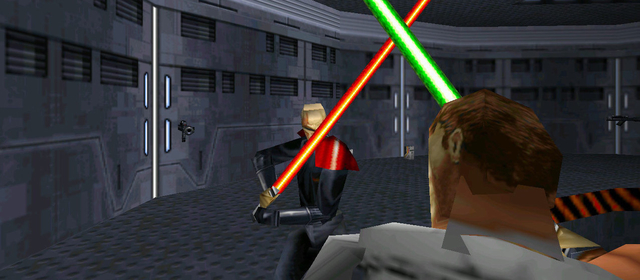Game: Star Wars Jedi Knight – Dark Forces II (1997)
Developer: LucasArts
Publisher: LucasArts
Originally Released on: Windows PC
Currently Available on: Steam
The closure of LucasArts Games has left many gamers around the world somewhat shell-shocked and saddened. And for good reason. LucasArts certainly created many of the greatest and most memorable video gaming titles when I was growing up. They produced a massive stable of top-class games – both original ones and movie tie-ins – that captured the imagination of a generation of players.
Personally, being an adventure game fanatic, I love the graphic adventures produced by LucasArts in the late nineteen-eighties and early nineties, with The Secret of Monkey Island, Day of the Tentacle and Grim Fandango – and many more – all ranking high in my list of the top games of all time. However, if adventure games is the first thing that fans think of when they hear the name LucasArts, the second thing would definitely be Star Wars. For better or worse, LucasArts produced a wide array of titles based on the Star Wars universe that George Lucas created with the first film in 1977. Strategy games, racing games, desktop utilities – nothing was safe from the merchandising of the Star Wars brand. And today we are going to take a look back at one of the most successful uses of the Star Wars license in gaming, the first/third-person shooter Star Wars Jedi Knight: Dark Forces II.
The original Dark Forces was released in 1995, at a time when first-person shooters were really starting to take hold of the gaming market. Doom had set things ablaze in 1993, and there had been many imitators since that time. But Dark Forces came along as a breath of fresh air. Rather than just slap a Star Wars license onto Doom, the title brought many new ideas and innovations to the FPS genre. The designers wanted to incorporate adventure elements into Dark Forces, so we find there are quite a few puzzles and a lot of exploration to do in game. Also, features such as jumping, crouching, swimming and looking up and down were featured – which were not common staples of the genre at that time. On top of all that, the game featured stages that had many levels, adding verticality to what was a relatively single-plane genre at the time. These developments were quite radical, and surely influenced the development of later shooters such as Quake.
 The game wasn’t without its detractors though. Of course, at the time it was made, three-dimensional graphics were still relatively new, so the in-game enemies were all more-or-less flat sprites in a 3D environment. That isn’t to say that Dark Forces didn’t look good – it featured a lot of new particle effects that hadn’t been seen in any other FPS games – but graphical improvements could certainly be made. And fans cried out in anger at the decision to not include the iconic Lightsaber in the game. Melee attacks consisted of fists only, as Kyle Katarn wasn’t a Jedi, so couldn’t wield a Lightsaber.
The game wasn’t without its detractors though. Of course, at the time it was made, three-dimensional graphics were still relatively new, so the in-game enemies were all more-or-less flat sprites in a 3D environment. That isn’t to say that Dark Forces didn’t look good – it featured a lot of new particle effects that hadn’t been seen in any other FPS games – but graphical improvements could certainly be made. And fans cried out in anger at the decision to not include the iconic Lightsaber in the game. Melee attacks consisted of fists only, as Kyle Katarn wasn’t a Jedi, so couldn’t wield a Lightsaber.
Who knows whether or not LucasArts had plans all along, but the fan outrage at the omission of this weapon may well have influenced the direction of the sequel. Coming two years later, Jedi Knight changed the Dark Forces mould entirely. You still play as Kyle Katarn – a space pirate very much in the same vein as Han Solo – but this time, following the death of his father, you learn that there are latent Jedi powers hidden within Kyle, just waiting to get out. His father was killed by a group of Dark Jedi, but luckily they missed the fact that he had hidden a Lightsaber for young Kyle – and that is where your Jedi training really begins in Dark Forces II.
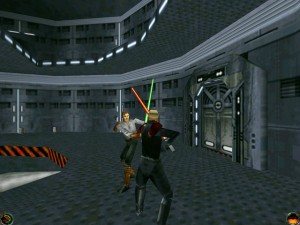 To accommodate the use of regular weapons and the Lightsaber, Dark Forces II allows players to switch between first-person and third-person views. Obviously the first-person one being optimised for aiming guns, and the third-person one makes melee fighting easier and lets players see the deflecting of blaster shots with the saber. Also, the game once again features a lot of jumping, crouching etc, as the levels are all designed in very clever ways, and light puzzling features quite regularly. The stages that you will fight through were all very inventive – maintaining and expanding upon the idea of verticality from the first Dark Forces. This time around, there are some levels of truly epic scale, where there are plenty of vertigo-inducing heights and the constant risk of falling to your doom.
To accommodate the use of regular weapons and the Lightsaber, Dark Forces II allows players to switch between first-person and third-person views. Obviously the first-person one being optimised for aiming guns, and the third-person one makes melee fighting easier and lets players see the deflecting of blaster shots with the saber. Also, the game once again features a lot of jumping, crouching etc, as the levels are all designed in very clever ways, and light puzzling features quite regularly. The stages that you will fight through were all very inventive – maintaining and expanding upon the idea of verticality from the first Dark Forces. This time around, there are some levels of truly epic scale, where there are plenty of vertigo-inducing heights and the constant risk of falling to your doom.
It is the level design, rather than the shooting in the game that actually really stays in the memory of those who played the title. Gamers wouldn’t necessarily remember the layout and objectives of most shooters that they last played around fifteen years ago – but the levels in Jedi Knight were really distinctive, clever and well-thought out. A particular highlight is the stage where Kyle is on-board a spaceship that is crippled and free falling through space. As you move throughout the level, the ship turns on its side and you have to traverse levels, making jumps onto platforms that were previously ceilings, and all the while crates and debris are flying around, and it appears as though the usual laws of gravity are thrown to the wind as the ship turns. This is such a memorable premise, and it makes you think about navigating the level in a different way. All of the stages in the game tried to introduce interesting and new ideas, to make them unlike anything you had played in any other shooter.
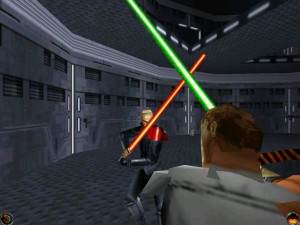 Of course, saying that the levels are more memorable than the shooting and the weapons isn’t to say that the weapons featured in Jedi Knight weren’t also one of the major attractions – they really were. The title features recognisable Star Wars weapons like the Stormtrooper blaster and thermal Detonators. But of course it is the ability to use a Lightsaber that takes centre stage – being something that Star Wars fans had of course fantasized about for decades. And the way in which it has been implemented in Jedi Knight is very effective. As previously mentioned, by switching into a third-person view, you get a better view of your sword-fighting, which really helps the Lightsaber combat. The combat may be somewhat simple – and more often than not a one-on-one duel just descends into randomly slashing as you run round in circles – but it remains strangely satisfying.
Of course, saying that the levels are more memorable than the shooting and the weapons isn’t to say that the weapons featured in Jedi Knight weren’t also one of the major attractions – they really were. The title features recognisable Star Wars weapons like the Stormtrooper blaster and thermal Detonators. But of course it is the ability to use a Lightsaber that takes centre stage – being something that Star Wars fans had of course fantasized about for decades. And the way in which it has been implemented in Jedi Knight is very effective. As previously mentioned, by switching into a third-person view, you get a better view of your sword-fighting, which really helps the Lightsaber combat. The combat may be somewhat simple – and more often than not a one-on-one duel just descends into randomly slashing as you run round in circles – but it remains strangely satisfying.
Each button press performs a swing of the Lightsaber, accompanied by the authentic buzzing sounds. It is especially fun when you switch from a gun to the Lightsaber, and are treated to the powering up whooshing sound and animation. It really was a treat for fans at the time to get to wield the legendary weapon. Unlike later games which asked you to deflect blaster shots yourself, by timing a button press, Jedi Knight automatically deflected them if you had your Lightsaber drawn and weren’t performing any other action. This helped to put across the idea of the effortless calm of the Jedi – being able to keep his enemies at bay with a minimum of effort – then charging in and attacking when they are ready. This was a whole lot of fun.
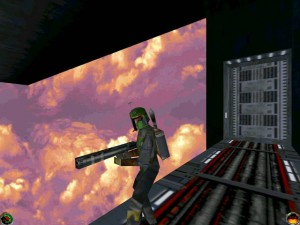
After you have experienced Lightsaber fights, you also have to consider that the title featured another iconic aspect of the Jedi way of life – Jedi Force Powers. For the first time, gamers could perform Force Push and Pull to lift items, like Yoda, or choke enemies from afar as Darth Vader famously does with Force Choke. But interestingly, players would have to make decisions during the game that would dictate whether they moved towards the dark or the light side of the force and, as such, had access to a different range of powers. Save your co-pilot for instance, and you will gain access to good powers such as Force Heal, but choose to let innocent people die, and you can get to use Force Lightning – just like Emperor Palpatine famously does in Return of the Jedi.
It was an interesting idea overall, that you could decide which side of the force that you would align yourself with, by your in-game actions. Not a lot of games at the time had offered this sort of choice and consequence in a title. Not only would your force allegiance change, but the actual story development and outcome would alter. Different cutscenes and slightly altered stages would come from your choices, which really added to the overall re-playability of the game.
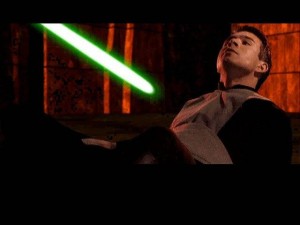 The music and sound design for the game was predictably excellent – what with having access to the huge banks of Star Wars audio, and with the fact that LucasArts have always worked with top-quality composers. The sound effects and music both help set the scene perfectly, and make the whole experience as close as being in the film series as you could possibly get at the time.
The music and sound design for the game was predictably excellent – what with having access to the huge banks of Star Wars audio, and with the fact that LucasArts have always worked with top-quality composers. The sound effects and music both help set the scene perfectly, and make the whole experience as close as being in the film series as you could possibly get at the time.
Speaking of cutscenes, when you think about the graphics and sound design in the title, you cannot ignore the full motion video cutscenes that played a prominent part in Jedi Knight. These all featured fully-costumed actors, acting out the dramatic interludes between levels. Of course, these were all filmed on green screens in order to save money, but they did capture the old-style Star Wars cheesy charm. Characters playing Aliens even featured full make-up and prosthetic elements, which made it all seem truly authentic to the films. The acting was also of a good quality, although it does stick in the memory that Jerec – the big bad guy – was quite slim and nimble in-game, but was quite old and fat in the cutscenes. This didn’t necessarily detract from the game though – it just provided a few extra laughs.
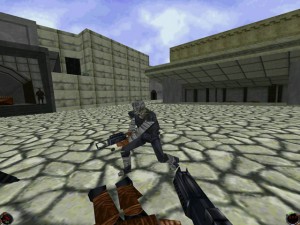 The title even featured some multiplayer modes, both over the internet and LAN-based play, which ensured that the game managed to live on, long after gamers had completed the story several times over. These modes may not have been very fully-featured, but it was a great starting point from which later Jedi Knight games could build upon. And who could turn down the chance to go up against both friends and strangers, in a Lightsaber duel, on a narrow bridge? You can’t get much more Star Wars than that – unless of course, you were playing online against your long-lost father. But I digress.
The title even featured some multiplayer modes, both over the internet and LAN-based play, which ensured that the game managed to live on, long after gamers had completed the story several times over. These modes may not have been very fully-featured, but it was a great starting point from which later Jedi Knight games could build upon. And who could turn down the chance to go up against both friends and strangers, in a Lightsaber duel, on a narrow bridge? You can’t get much more Star Wars than that – unless of course, you were playing online against your long-lost father. But I digress.
With Dark Forces 2: Jedi Knight being currently available on Steam, a whole new generation of gamers has the chance to experience a truly revolutionary title not just in the realms of Star Wars games, but first-person shooters in general. Jedi Knight took risks, and most of them paid off. The graphics may well have aged quite badly, as early 3D modelling has tended to over the years, but if you can look past that then there is plenty to enjoy through playing the game now, approaching two decades on from its original release. the Force was certainly strong with this one.
The God is a Geek Retro Corner will return on the first Friday of next month. You can see previous entries into the GodisaGeek Retro Corner by clicking here.


